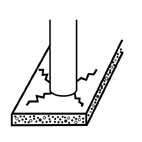| Case Name |
In the erection of parking lot development project, the concrete pavement construction does not achieve the purpose of the construction because it is remarkably different from the design. |
| Pictograph |

|
| Date |
1995 |
| Place |
Chuo Ward, Tokyo |
| Location |
Parking lot construction field |
| Overview |
In body construction of the parking lot, the radical cracks were generated on each column and the durability of the pavement was lowered remarkably because of not carrying out the work according to the design drawing. After being examined, the construction of the concrete pavement was remarkably different from construction designing, and the purpose of the construction was not achieved, and government subsidy, a considerable amount of \ 9281,500 which was allocated to this, was considered unreasonable. |
| Incident |
In the body construction, the main body of the parking lot, which was a reinforced concrete structure, was constructed. On the floor slab concrete, a total 6567m2 concrete pavement whose thickness was from 8cm to 23cm (average 23 cm) was constructed for automobiles to drive and park on. According to the design drawing, on this concrete pavement, the total space would be devided into 4 blocks from 135m2 to 1903m2. Each 1 block would be constructed as follows:.
1) The spring-water mat for groundwater is laid on the floor slab concrete
2) To prevent the progress of generating cracks by the strengthening of the upper part concrete pavement which greatly receives the effect of the automotive load and to improve the durability, the iron network ( diameter of 6 millimeters, network of 15 cm X 15 cm ) was installed on the spring water mat in order to change the position under 5 cm from the finished pavement surface using the spacer. Then, the concrete is placed, while the position of the iron network was confirmed.
3) On the next day after the concrete installation, the pavement was cut off from the surface to the bottom and the joints were made by concrete cutter in intervals (length 5.6m and width 8.5m) of 118 columns, to prevent the generation of the noxious cracks which affected the durability because of the contraction from drying and the stretching from the change in the temperature.
When this was examined, the radical cracks on each column were generated over the full face on the concrete pavement. Then, it consists as follows, when joints, etc. were investigated.
1) The joints were discontinued to the depth of 2 cm from the surface without reaching the bottom face of the pavement. Therefore, the concrete pavement became a large structure whose area of one sheet was from 1351m2 to 1903m2. The noxious crack was then easily generated without sufficiently dealing with drying contraction etc.
2) The cores from 6 places or 7 places, total 25 places per block inside the crack parts were collected and investigated. The positions of iron network of confirmed 24 cores were overall 5cm downward from the surface of the pavement and half of them were 10cm downward. The cracks reached the bottom face of the pavement in all 25 of which were collected as the core, and it was confirmed that the durability lowered remarkably in this case. |
| Sequence |
* Earthwork, body construction etc were carried out by government subsidies totaling \1,351,974,225 so that the Chuo Ward in Tokyo set up the parking lot (accomodation of 200 automobiles, one floor of the underground) in the underground in the park in Nihonbashi Hamacho district.
* In the body construction, the main body of the parking lot which was a reinforced concrete structure was constructed. A concrete pavement totaling 6561m2 was constructed.
* The radical cracks were generated on each column because of not carrying out the work according to the design drawing.
* The construction of the concrete pavement was remarkably different from construction designing, and the purpose of the construction was not achieved, and the government subsidy of the considerable amount of \ 9,281,500 which was allocated for this was considered unreasonable. |
| Cause |
The joint did not reach the bottom face of the pavement. And, the concrete was placed even though the spacers fell and sank. |
| Scenario |
| Primary Scenario
|
Ignorance, Insufficient Knowledge, Non-Regular Action, Change, Failure, Fracture/Damage, Damage to Society, Social Systems Failure
|
|
| Sources |
The 1996 fiscal year settlement inspection report ( Board of Audit ).
|
| Financial Cost |
Government subsidy delivery amount considered unreasonable \ 9281,500. |
| Multimedia Files |
Fig2.Concrete pavement concept chart
|
| Field |
Civil Engineering
|
| Author |
YONEZAWA, Akio (The University of Tokyo)
KUNISHIMA, Masahiko (The University of Tokyo)
|
|